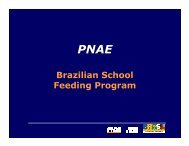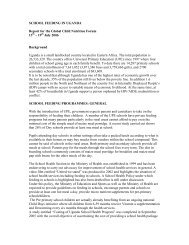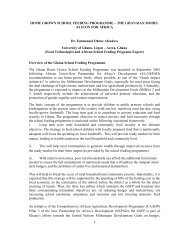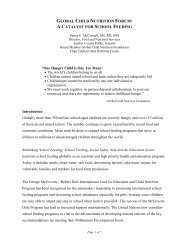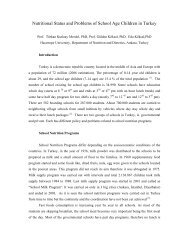EXECUTIVE SUMMARY - Global Child Nutrition Foundation
EXECUTIVE SUMMARY - Global Child Nutrition Foundation
EXECUTIVE SUMMARY - Global Child Nutrition Foundation
You also want an ePaper? Increase the reach of your titles
YUMPU automatically turns print PDFs into web optimized ePapers that Google loves.
toddlers were underweight. About one third of the world’s 146<br />
million undernourished children live in India, a country whose<br />
GDP growth will push its economy past Great Britain’s in 2020<br />
and Japan’s in 2030.<br />
Finally, the MDMS program must address breakfast<br />
requirements, strengthen the links between the government’s<br />
nutrition and health sectors, work on food-absorption issues such<br />
as safe drinking water and clean toilets and improve levels of<br />
community participation.<br />
Public-private partnerships offer innovative models for the<br />
government to scale up.<br />
The Akshaya Patra <strong>Foundation</strong>’s vision statement—“No child<br />
in India shall be deprived of education because of hunger”—<br />
explicitly links malnutrition to educational failure. This NGO<br />
considers educational attainment the key both to an improved<br />
personal standard of living that breaks the poverty cycle and to<br />
broader national competitive goals.<br />
Complementing the Indian government’s efforts in school<br />
feeding, Akshaya Patra has developed innovative ways to<br />
prepare fresh food in volume for schoolchildren. For example, in<br />
one of its commercial-scale kitchens, a giant steamer can cook<br />
rice for 1,000 children in 15 minutes, and an automated maker<br />
can turn out 40,000 chapatis an hour. These hot foods are then<br />
delivered throughout an eight-state region by a fleet of trucks.<br />
Its award-winning kitchens feature a creative “three-stage gravityflow<br />
mechanism” to take raw delivered grains and process them<br />
into transportable meals.<br />
Scaling Up Sustainability: Linking School Feeding with Agriculture<br />
Development to Maximize Food Security<br />
May 3-7, 2011<br />
Nairobi, Kenya<br />
© 2011 GCNF and PCD. All rights reserved. Page 20<br />
“In Jaipur, 18% of the children said they would<br />
not have attended school if there were no meals.”<br />
C.P. Das, Akshaya Patra <strong>Foundation</strong><br />
Akshaya Patra, which means “inexhaustible vessel” in Sanskrit,<br />
funds its operations through a mix of government per-child<br />
subsidies and contributions from a broad network of partner firms<br />
operating in the country, from Mysore Minerals and Infosys<br />
Technologies to Citigroup and Cisco.<br />
KPMG audits its finances, and A.C. Nielsen tracks its<br />
performance against metrics such as school attendance,<br />
classroom performance, and student nutritional status. Some<br />
before-and-after results:<br />
Location Metric Result<br />
Bangalore 1 st grade enrollment 21%<br />
Bangalore Drop-out rate 8% to 18%<br />
Hubli 5 th grade enrollment 31%<br />
Vrindavan Underweight population 26% to 38%<br />
Although it now feeds almost 1.3 million children in India,<br />
Akshaya Patra’s efforts are dwarfed by the centralized federal<br />
program for 113 million students. Nonetheless, its innovations in<br />
infrastructure, kitchen construction, and distribution provide<br />
prototypes the national government can exploit on a larger scale.



